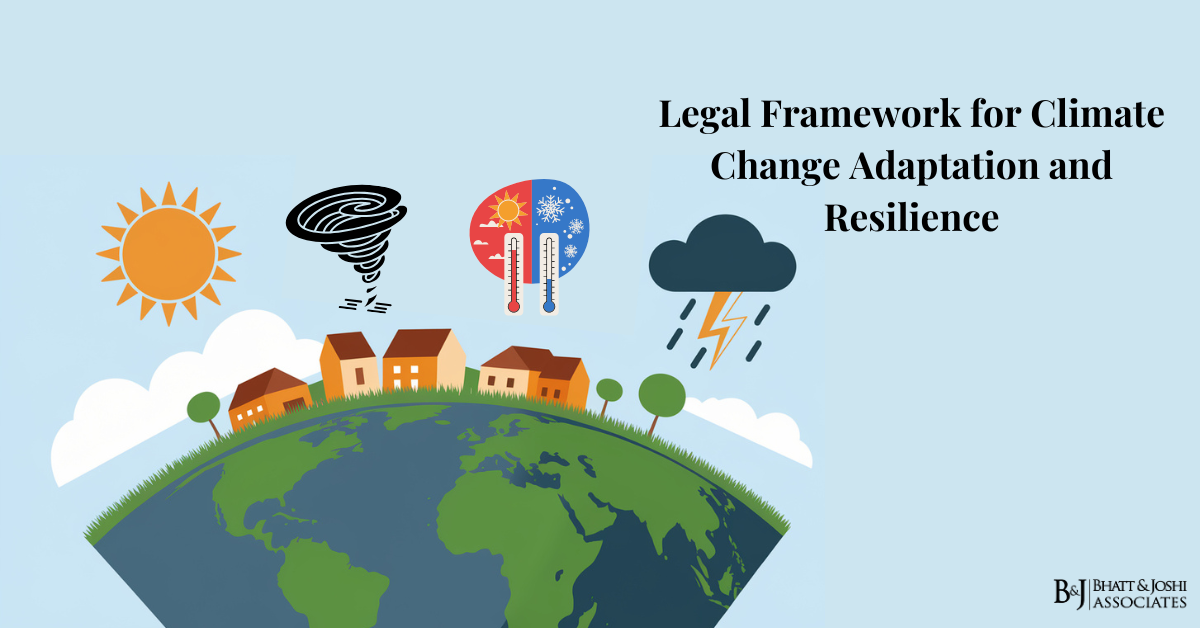Introduction
The global threat of climate change has escalated to unprecedented levels, influencing every aspect of human life, environment, and economies. Its impacts—ranging from rising sea levels, heatwaves, erratic weather patterns, floods, and droughts—are being increasingly felt across the world. These environmental changes directly threaten the survival of ecosystems, biodiversity, and human settlements. With the realization that mitigation alone cannot address the full spectrum of climate impacts, the focus has increasingly shifted towards climate change adaptation and building resilience. A well-structured legal framework is essential for facilitating climate change adaptation and resilience, both globally and locally, ensuring that nations are well-equipped to cope with the challenges posed by this planetary crisis.
This article aims to explore the existing legal frameworks governing climate change adaptation and resilience, both at the international and national levels. It further examines relevant laws, case laws, and judicial pronouncements that are pivotal in fostering the development and implementation of adaptive strategies to climate change.
Defining Climate Change Adaptation and Resilience
Climate change adaptation refers to the process of adjusting natural or human systems in response to actual or expected climate stimuli, thereby moderating potential damages or taking advantage of new opportunities. Adaptation can be reactive or anticipatory and involves a broad array of activities, such as modifying infrastructure, adopting new agricultural practices, and revising policies to reflect emerging climatic realities. Resilience, on the other hand, is the capacity of a system—be it an ecosystem, community, or economic sector—to absorb shocks, adapt to stressors, and continue functioning despite climate-induced disturbances.Adaptation and resilience are integral to climate policy, as they focus on ensuring that systems can withstand the adverse effects of climate change while maintaining essential functions. A sound legal framework is critical for promoting adaptation strategies and resilience-building efforts, ensuring that policy goals are met and protecting communities, particularly those most vulnerable to climate change.
International Legal Frameworks for Climate Change Adaptation
At the global level, the recognition of climate change adaptation as a critical component of climate policy is reflected in several key international agreements, conventions, and frameworks. These instruments provide countries with the legal basis for enacting policies and measures to foster adaptation and resilience.
United Nations Framework Convention on Climate Change (UNFCCC)
The UNFCCC, adopted in 1992, is a cornerstone of international climate governance. While primarily focused on mitigation efforts, the convention explicitly acknowledges the importance of adaptation, particularly for developing nations. Article 4.1 of the UNFCCC outlines the obligations of parties to formulate, implement, and regularly update measures aimed at mitigating climate impacts, as well as facilitating adequate adaptation.
The convention laid the groundwork for several subsequent agreements that further enhanced global cooperation on climate adaptation. One such initiative is the National Adaptation Programmes of Action (NAPAs), designed to assist Least Developed Countries (LDCs) in identifying and addressing their most urgent adaptation needs. NAPAs provide a blueprint for countries to develop strategies to enhance their resilience to climate impacts in sectors such as water resources, agriculture, and infrastructure.
The Paris Agreement
The Paris Agreement of 2015 represents a milestone in the global fight against climate change. Article 7 of the Paris Agreement explicitly focuses on climate change adaptation, recognizing it as a global challenge with local, regional, national, and international dimensions. The agreement sets out a Global Goal on Adaptation, aiming to enhance adaptive capacity, strengthen resilience, and reduce vulnerability to climate change, thereby contributing to sustainable development.
The Paris Agreement obliges parties to undertake and communicate their adaptation efforts through adaptation communications. These communications provide insight into countries’ priorities, implementation strategies, and support needs, fostering a transparent exchange of information and best practices. The agreement also established the Adaptation Fund, which finances projects and programs that help vulnerable communities in developing countries adapt to climate change.
Moreover, the Paris Agreement emphasizes the importance of ensuring that adaptation efforts are integrated into national policies. This integration is vital for achieving long-term sustainability, particularly as climate risks grow more pronounced. The Global Stocktake, another key component of the Paris Agreement, monitors the progress of adaptation efforts and encourages countries to enhance their contributions as climate impacts intensify.
Sendai Framework for Disaster Risk Reduction (2015–2030)
The Sendai Framework for Disaster Risk Reduction, although not exclusively focused on climate change, is highly relevant to adaptation and resilience strategies. The framework underscores the importance of reducing disaster risks, which are often exacerbated by climate change, such as extreme weather events, flooding, and drought. The Sendai Framework encourages countries to integrate disaster risk reduction into their development policies, building resilience against both natural and climate-induced hazards. The Sendai Framework highlights the need for proactive risk management, which aligns with adaptation strategies aimed at minimizing the adverse effects of climate change. It emphasizes resilience-building as an ongoing process, requiring sustained efforts to reduce vulnerability and enhance the capacity of societies to recover from climatic shocks.
National Legal Frameworks for Climate Change Adaptation and Resilience
At the national level, the legal frameworks governing climate change adaptation and resilience vary significantly across countries. While some nations have enacted specific climate change legislation, others incorporate adaptation strategies into broader legal frameworks related to environmental management, urban planning, and disaster risk reduction.
India
India, one of the countries most vulnerable to climate change, has developed a comprehensive legal framework for addressing climate adaptation and resilience. The country’s National Action Plan on Climate Change (NAPCC) serves as the central policy guiding its response to climate impacts. The NAPCC comprises eight national missions, including the National Mission for Sustaining the Himalayan Ecosystem, the National Water Mission, and the National Mission on Sustainable Agriculture. These missions focus on sectoral adaptation strategies aimed at reducing vulnerability to climate change.
In addition to the NAPCC, India has integrated climate adaptation into several key pieces of legislation. The Environment Protection Act, 1986, provides a legal foundation for addressing environmental concerns, including those related to climate change. The Disaster Management Act, 2005, is another crucial law, requiring the development of disaster management plans that now increasingly incorporate climate adaptation measures.
The Indian judiciary has also played a pivotal role in advancing climate justice through landmark rulings. In MC Mehta v. Union of India, the Supreme Court recognized the necessity of adopting precautionary measures to mitigate environmental degradation and climate risks. This case emphasized the role of the judiciary in compelling the government to act proactively in addressing climate impacts, particularly through legal frameworks that support adaptation strategies.
United States
In the United States, the legal framework for climate adaptation and resilience is primarily shaped by federal, state, and local policies. Although climate adaptation efforts have historically been fragmented, recent developments have placed greater emphasis on national strategies. The National Climate Assessment, published periodically by the U.S. government, highlights the risks posed by climate change and underscores the need for adaptation measures in key sectors such as infrastructure, agriculture, and water management.
The Clean Water Act and the Clean Air Act have been instrumental in addressing climate-related issues in the United States, though they primarily focus on mitigation. In the landmark case Massachusetts v. Environmental Protection Agency (EPA), the U.S. Supreme Court ruled that greenhouse gases are pollutants under the Clean Air Act, opening the door for federal regulation of emissions. This ruling has had significant implications for adaptation, as it compels the government to account for climate risks when formulating environmental policies.
At the state level, several U.S. states have adopted climate adaptation plans, reflecting the importance of localized responses to climate impacts. California, for instance, has developed the Safeguarding California Plan, which outlines comprehensive strategies for enhancing resilience across critical sectors, including water resources, public health, and natural ecosystems.
European Union
The European Union (EU) is a global leader in climate policy, and its legal framework for adaptation is one of the most comprehensive in the world. The EU Adaptation Strategy, adopted in 2013 and revised in 2021, provides a robust framework for fostering climate resilience across member states. The strategy encourages all EU countries to develop national adaptation plans, integrating climate risks into decision-making processes across sectors such as energy, transport, and agriculture.
The European Climate Law, adopted in 2021, legally enshrines the EU’s goal of achieving climate neutrality by 2050. The law emphasizes the importance of adaptation, requiring the European Commission to assess the adequacy of adaptation measures regularly and ensure that member states take steps to strengthen their resilience to climate impacts.
Moreover, the EU’s Green Deal, a comprehensive policy package aimed at promoting sustainability and combating climate change, places a strong emphasis on adaptation. It calls for investments in green infrastructure, nature-based solutions, and the promotion of resilience-building initiatives across the EU.
Case Laws and Judicial Precedents on Climate Adaptation
Courts worldwide are increasingly addressing the legal obligations of governments and corporations in relation to climate change adaptation. Several landmark cases have set precedents for ensuring that governments take adequate measures to protect their citizens from climate risks, holding them accountable for failures to act.
Urgenda Foundation v. The State of the Netherlands
In 2015, the Dutch courts delivered a groundbreaking ruling in Urgenda Foundation v. The State of the Netherlands. The Urgenda Foundation, a Dutch environmental group, argued that the government’s climate policy was insufficient to protect citizens from the risks of climate change. The court ruled that the Dutch government had a duty to prevent dangerous climate change and ordered it to take more aggressive measures to reduce greenhouse gas emissions.
While the Urgenda case primarily focused on mitigation, its implications for adaptation are profound. The ruling emphasized the duty of governments to protect their citizens from the impacts of climate change, which includes enhancing resilience to climate risks. The decision set a legal precedent for holding governments accountable for failing to address the broader spectrum of climate challenges, including adaptation.
Leghari v. Federation of Pakistan
In 2015, the Lahore High Court in Pakistan delivered a landmark ruling in the case Leghari v. Federation of Pakistan. The petitioner, a farmer named Asghar Leghari, challenged the Pakistani government’s failure to implement its climate adaptation policies. The court ruled in favor of Leghari, recognizing climate change as a human rights issue and directing the government to take immediate action to enforce its National Climate Change Policy and Framework for Implementation.
The Leghari case underscored the role of the judiciary in ensuring that governments fulfill their obligations under climate adaptation frameworks. It highlighted the importance of timely and effective adaptation measures, particularly in regions that are highly vulnerable to climate impacts. The ruling also emphasized that climate adaptation is not merely a policy choice but a legal obligation, grounded in the duty of the state to protect its citizens from harm.
Juliana v. United States
In the United States, the case Juliana v. United States is another example of climate litigation that addresses the role of the government in protecting future generations from the impacts of climate change. Filed in 2015, the case was brought by 21 youth plaintiffs who argued that the U.S. government’s failure to adequately address climate change violated their constitutional rights to life, liberty, and property. While the case has faced procedural challenges, it has sparked a broader conversation about the government’s responsibility to protect citizens from climate impacts, including the need for robust adaptation strategies.
Challenges in Implementing Legal Frameworks for Climate Change Adaptation
Despite the growing recognition of the need for climate change adaptation, there are several challenges in implementing effective legal frameworks to promote adaptation and resilience. One of the primary challenges is the fragmentation of policies across different sectors and levels of government, which often results in inconsistent and inadequate adaptation efforts. This lack of coordination can hinder the effective implementation of adaptation measures, particularly in regions that are most vulnerable to climate impacts.
Another significant challenge is the need for stronger legal mechanisms that compel governments and corporations to take action on climate adaptation. Many countries have developed adaptation strategies, but these plans are often non-binding, making it difficult to enforce their implementation. In the absence of legally binding commitments, adaptation measures may be neglected, particularly in the face of competing political and economic priorities.
Furthermore, financial constraints pose a significant barrier to implementing adaptation strategies, particularly in developing countries. While international mechanisms such as the Adaptation Fund provide some financial support, the scale of the challenge requires far greater resources. Legal frameworks must therefore include provisions for mobilizing adequate financial resources to support adaptation efforts, ensuring that vulnerable communities have the necessary resources to build resilience.
Conclusion: Building Legal Resilience for Climate Chang Adaptation
The legal framework for climate change adaptation and resilience is critical in ensuring that nations and communities are prepared to cope with the challenges posed by a changing climate. Both international and national legal frameworks play an essential role in guiding adaptation strategies, ensuring that governments take proactive steps to protect their citizens from climate impacts. Judicial rulings have further strengthened the case for climate adaptation, emphasizing the legal obligations of governments to take timely and effective action.
Moving forward, there is a need for more robust and binding legal frameworks that prioritize adaptation, promote resilience, and safeguard the rights of those most vulnerable to climate change. Legal reforms should focus on addressing the fragmentation of adaptation policies, ensuring that they are implemented coherently across sectors and levels of government. Additionally, legal frameworks must include strong accountability mechanisms to ensure that adaptation measures are not only planned but also effectively executed. Through sustained legal efforts, the global community can build resilience to the inevitable impacts of climate change and ensure a sustainable future for all.














